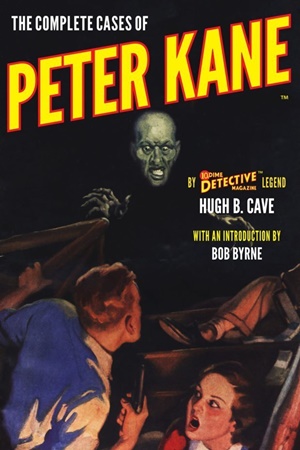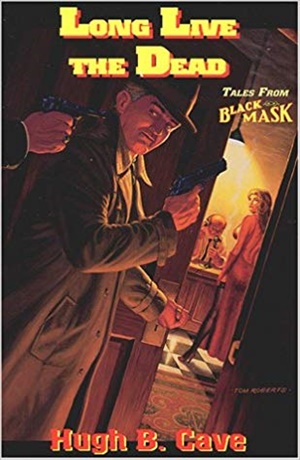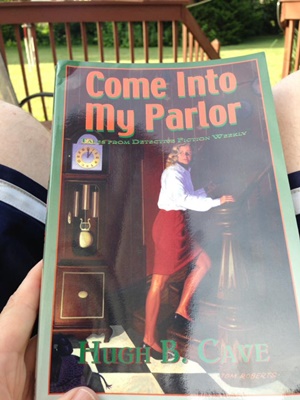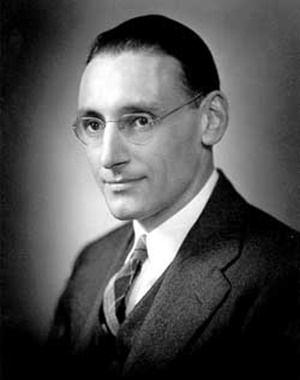A (Black) Gat in the Hand: Hugh B. Cave’s Peter Kane
 “You’re the second guy I’ve met within hours who seems to think a gat in the hand means a world by the tail.” – Phillip Marlowe in Raymond Chandler’s The Big Sleep
“You’re the second guy I’ve met within hours who seems to think a gat in the hand means a world by the tail.” – Phillip Marlowe in Raymond Chandler’s The Big Sleep
(Gat — Prohibition Era term for a gun. Shortened version of Gatling Gun)
Matt Moring of Steeger Books (and Altus Press, and Black Mask, and…) allowed me to write the introduction to Hugh B. Cave’s The Complete Cases of Peter Kane. Matt has kindly let me reproduce that intro as an entry here for A (Black) Gat in the Hand.
Hugh B. Cave was the last of the great pulpsters. From hundreds of short stories in the pulp magazines of the thirties, to his final novel in 2004, Cave wrote over a thousand shorts and over three dozen novels. He was also a war reporter and later even owned and managed a coffee plantation in Jamaica.
While H.P. Lovecraft, Clark Ashton Smith, August Derleth and Robert E. Howard are better remembered for weird menace/horror stories, Cave is worthy of standing alongside them. But early in his career, Cave also wrote extensively in the mystery field.
He was one of the few to write for the last three (named) editors of the king of mystery pulps, Black Mask: the legendary Joseph ‘Cap’ Shaw, Fanny Ellsworth and Kenneth S. White.
Black Mask’s major competition came in the form of Dime Detective Magazine, which touted itself as “twice as good – for half the price” (Black Mask cost 20 cents at the time; though the price would shortly drop to 15 cents, in part due to Dime Detective’s success at the cheaper cost).
Editor Kenneth White (the same mentioned above) was instructed to lure as many writers from Black Mask as he could, paying an extra penny a word as enticement. And with a going rate of one to two cents for pulp writers (Black Mask’s three cents a word was indicative of its standing and quality in the field), the four cent rate made a significant difference to writers. As the prolific Erle Stanley Gardner supposedly replied to observations that he always seemed to use his hero’s last bullet to knock off the story’s antagonist:
“At three cents a word, every time I say ‘Bang’ in the story I get three cents. If you think I’m going to finish the gun battle while my hero still has fifteen cents worth of unexploded ammunition in his gun, you’re nuts.”
Writers were forbidden from doing novel serializations (The Maltese Falcon was first a serial) and were also instructed to create their own characters, which could not appear elsewhere, for the magazine. The onslaught was successful, with many of the era’s most popular writers switching to Dime Detective. Carroll John Daly (who brought the iconic Race Williams with him), Erle Stanley Gardner, Frederick Nebel and Norbert Davis (whose humorous stories were frequently rejected by Shaw but who flourished at his new home) were among those lured to Dime Detective.
 Some authors would publish stories in other magazines but never return to Black Mask after moving to Dime Detective. Many fans would say that the best of those who switched was Frederick Nebel, Cap Shaw’s handpicked successor to Hammett when Dash left the pulps for more lucrative writing pastures. I’m one of those fans.
Some authors would publish stories in other magazines but never return to Black Mask after moving to Dime Detective. Many fans would say that the best of those who switched was Frederick Nebel, Cap Shaw’s handpicked successor to Hammett when Dash left the pulps for more lucrative writing pastures. I’m one of those fans.
Nebel was the creator of Black Mask staples MacBride and Kennedy and Tough Dick Donahue, and his Jack Cardigan of the Cosmos Detective Agency dominated the pages of Dime Detective. Collections for all three series’ are available here at Altus Press.
But for the combination of entertainment value and quality writing, Cave, who was far more than just a weird menace pulpster, might have topped the list with his Peter Kane stories (though Davis’ Max Latin probably has his adherents).
And now that we’ve finished the ‘Dime Detective Primer’ portion of our Introduction, let’s turn to the star of this book!
Cave wrote for over a dozen mystery pulps, including Black Book Detective, Detective Fiction Weekly, Double Detective, Private Detective Stories, Super Detective Stories and Spicy Detective Stories (notice a common theme in naming conventions?). He had largely left the detective genre by the mid-forties, focusing his efforts in other fields – especially the horror/weird menace genre. There would be a story here and there, with brief spurts of activity in the field, but Cave’s mystery days were effectively behind him.
Long before Robert B. Parker, William Tapply, Linda Barnes and others made Boston the backdrop for their mysteries, New Englander Cave was already there. From August, 1934 through July, 1935, Dime Detective featured six tales of Peter Kane, the biggest and best detective at Boston’s Beacon Agency. The private eye would return in August and November of 1941, with a final appearance in February of 1942.
Kane was a Drunk. Note the capital ‘D.’ He didn’t have hangovers because he was always too drunk to enter hangover mode (that’s a slight exaggeration, but not by much). Yet, somehow, he functioned while constantly inebriated to varying degrees.
The picture is painted pretty clearly in the first paragraph of the debut story, The Late Mr. Smythe:
“The room was beginning to go round and round, faster and faster, like a monstrous revolving barrel in a beach-resort playhouse. Peter Kane heaved himself off the bed and stood swaying. He had flopped into bed drunk. Now, after sleeping five hours and lying awake for another hour, staring at an unsteady ceiling, he was drunker. And sick.”
Here’s our initial view of him in the following tale, Hell on Hume Street:
“Peter Kane…was drunk. Kane had been drunk more or less, mostly more, for a period running into its third liquid week. He knew he was drunk and he liked to be drunk.”
It would be easy to dismiss Kane as just a caricature: A stereotype of the drunken, ex-cop PI. But Cave is too good of a writer to let that happen. Anne, Kane’s former girlfriend, now married to police captain Moe Finch, enters after that description and we read:
“Kane put both hands on the table and pushed himself to his feet, wishing suddenly that he were not drunk, at least not so drunk that it showed… Then he wanted to be very drunk, because there was something in the woman’s dark eyes, something accusing and – and pitying – that made him feel really rotten down inside.”
Then we learn about Kane’s past relationship with Anne, how and why it ended, and the role that Moroni, Kane’s rival on the force, played in it all. The groundwork is in place for the rest of the series. And it is all deftly handled by Cave.
Cave excels in describing Kane’s drunken movements and moments: “…his top-heavy body rocked from side to side…,” and “Steering an unsteady course….” And that’s just on page one of the first story.
“On a job like this, with Large Mouth Moroni and a lot of heaving green ocean all over the place, the only thing to do was to get thoroughly plastered and remain that way.”
In the hands of a lesser writer, the final confrontation in “Hell on Hume Street” would read like a farce. But there’s nothing funny the way Cave tells it. Hugh B. Cave was a Writer with a capital ‘W.’
 There are two regulars in the series: Captain Moe Finch, Kane’s former boss on the force, and Lieutenant Moroni. Both appear in eight of the nine stories, in very different roles.
There are two regulars in the series: Captain Moe Finch, Kane’s former boss on the force, and Lieutenant Moroni. Both appear in eight of the nine stories, in very different roles.
Kane despises Moroni. When he finds a mechanical cockroach, he names it Moroni. Throughout the series, the cop is tagged with sneering nicknames such as ‘The Wise One,’ ‘Know It all’ and ‘The Great Brain.’
We learn early on that when Kane was going off the rails with drink, Moroni helped ensure that Kane (a better detective than he was) was booted from the force. And a drunk with no job was a bad bet for a young woman – so even though Anne loved Kane, she married Moe Finch. Anne is presented as noble and good, though there’s certainly another angle one could take on that.
Moroni yells and bullies, though it doesn’t appear that he beats confessions out of suspects. His deductions aren’t terrible, but he’s always wrong – and Kane’s always (eventually) right. It’s certainly not beyond Kane to let Moroni think that the policeman is on the right track: and then expose him at the finish. And in front of the press when suitable.
Moroni wants Finch’s job. He constantly arranges matters so that he gets the credit when things go well, and mildly explains that he was just following Finch’s directions when they don’t. He grows more ambitious, snarling at Kane “I had my fill of you when Moe Finch was in his prime, Kane. I’ve got more to say now, and I’m tough!”
Kane never responds in kind to Moroni’s volume and anger. Throughout the series, he replies softly, but clearly in a dismissive manner: “Dear, dear,” “Wouldn’t I, though?” “I’m all ears,” “’In case you hadn’t noticed, he’s dead,’ Kane said, shaking his head in mock pity.”
Moroni hates Kane at least as much as Kane hates him, so their enmity is a constant. It’s almost jarring when they sort of, kind of work together in The Man Who Looked Sick.
The other regular is police captain Moe Finch, who comes across as a weak sister. He mostly whines to Kane about needing his help, occasionally shifting to resignedly complaining that Moroni is undermining him. Finch is, frankly, tiresome:
“The voice took on a plaintive wine. ‘I thought you was gonna help me out Kane. I thought you were gonna stay sober long enough to be a pal. Here I am in a jam, and you were gonna…’”
“…and for an hour (Finch) moaned his troubles into Kane’s unwilling ears…’I’m in a spot. I need help. Even from a drunken, no-good private shamus like you, I need help…Be a pal.’”
“”I been hoping you’d show up. So help me, I’m frantic…You’re a pal, Kane; so help me, you are. I figured you’d be out drinking somewhere…Where you going?’ Finch wailed.”
“I thought you were going to be a pal and help me out. Now look! Plastered to the gills!”
‘Moe Finch looked small and worried behind his desk.’
Finch never actually steps up even once, though Cave does paint him as a devoted husband and noble cop who doesn’t have time to cater to the press and play the political game in the latter part of the series. But it doesn’t really salvage Finch, who seems to exist primarily so somebody ‘good’ wins when Kane beats Moroni. It’s a rather unsatisfying role.
Of the nine stories, “The Screaming Phantom” is notable for a couple of reasons. First and foremost, it’s a weird menace story, and that’s the genre in which Cave is regarded as one of the best. Kane, drunk as usual, and thus hours late for an out-of-town assignment, finds himself driving past a closed amusement park in the dead of night (and the dead of winter). He witnesses (he thinks) a screaming, naked girl riding in a roller coaster car that is guaranteed to go flying off of the icy tracks. There’s more spookiness, murder and rough stuff for Kane in as the story goes on. Because of the weird menace overtones, it’s one of my favorites.
 Normally, Kane sums up the case at police headquarters, explaining things to a grateful Finch and an angry Moroni. That’s not gonna work in this story. So, we find Kane, sitting at his desk at the Beacon Detective Agency, drinking from the bottle he keeps in a drawer and explaining things to the ‘competent blonde’ who woks in the office. Kane had stopped at his desk in one earlier story, grabbing some mail and leaving. This gumshoe drinks and goes places. He actually does his thinking in a bar called Limpy’s. His office is not an important part of the series, but it’s where this story ends.
Normally, Kane sums up the case at police headquarters, explaining things to a grateful Finch and an angry Moroni. That’s not gonna work in this story. So, we find Kane, sitting at his desk at the Beacon Detective Agency, drinking from the bottle he keeps in a drawer and explaining things to the ‘competent blonde’ who woks in the office. Kane had stopped at his desk in one earlier story, grabbing some mail and leaving. This gumshoe drinks and goes places. He actually does his thinking in a bar called Limpy’s. His office is not an important part of the series, but it’s where this story ends.
The first couple stories involve typical city settings. “The Screaming Phantom” put Kane in a more distinctive locale; a closed-down amusement park. The next story, “The Brand of Kane,” forced the drunken detective to work aboard a grounded steamship. “The Dead Don’t Swim” is out of town and the final tale, “No Place To Hide,” takes place in a country rest home. So, Cave expanded his terrain in the later stories – possibly to keep his interest in the character.
Kane brings to mind Carroll John Daly’s Race Williams, who came before, and Mickey Spillane’s Mike Hammer, who came after. Simply put, Cave was a better writer than Daly. And it’s hard to put a finger on it, but Kane has more depth (though a lot less sex!) than the ultra-hard-boiled Hammer. Cave’s plotting is relatively straight-forward compared to the labyrinthine mazes created by Raymond Chandler. But they’re not simple and they allow Kane and Moroni to go down separate mean streets before coming back together for the finale. And that is a key element of the series.
You hold in your hands perhaps the best of the hard drinking, two fisted pulp private eyes. Kane is not well-remembered in the field, and the stories are not routinely listed among Cave’s best works. But the Boston detective can stand up to Philip Marlowe, Jack Cardigan, Sam Spade and the others; though he might wobble a little and have trouble focusing on them!
Bob Byrne blogs for the World Fantasy Award-winning site, BlackGate.com and has contributed to several volumes of the MX Book of New Sherlock Holmes Stories. He is a leading expert on August Derleth’s Solar Pons (www.SolarPons.com) and has been nominated multiple times for The Robert E. Howard Foundation Awards. He is a periodic contributor to Black Mask Magazine.
Prior posts in A (Black) Gat in the Hand – 2019 Series
Back Deck Pulp Returns
A (Black) Gat in the Hand Returns
A (Black) Gat in the Hand: Will Murray on Doc Savage
A (Black) Gat in the Hand – 2018 Series
With a (Black) Gat: George Harmon Coxe
With a (Black) Gat: Raoul Whitfield
With a (Black) Gat: Some Hard Boiled Anthologies
With a (Black) Gat: Frederick Nebel’s Donahue
A (Black) Gat in the Hand: Thomas Walsh
A (Black) Gat in the Hand: Black Mask – January, 1935
A (Black) Gat in the hand: Norbert Davis’ Ben Shaley
A (Black) Gat in the Hand: D.L. Champion’s Rex Sackler
A (Black) Gat in the Hand: Dime Detective – August, 1939
A (Black) Gat in the Hand: Back Deck Pulp #1
A (Black) Gat in the Hand: W.T. Ballard’s Bill Lennox
A (Black) Gat in the Hand: Day Keene
A (Black) Gat in the Hand: Black Mask – October, 1933
A (Black) Gat in the Hand: Back Deck Pulp #2
A (Black) Gat in the Hand: Black Mask – Spring, 2017
A (Black) Gat in the Hand: Frank Schildiner’s ‘Max Allen Collins & The Hard Boiled Hero’
A (Black) Gat in the Hand: William Campbell Gault
A (Black) Gat in the Hand: More Cool & Lam From Hard Case Crime
A (Black) Gat in the Hand: MORE Cool & Lam!!!!
A (Black) Gat in the Hand: Thomas Parker’s ‘They Shoot Horses, Don’t They?’
A (Black) Gat in the Hand: Joe Bonadonna’s ‘Hardboiled Film Noir’ (Part One)
A (Black) Gat in the Hand: Joe Bonadonna’s ‘Hardboiled Film Noir’ (Part Two)
A (Black) Gat in the Hand: William Patrick Maynard’s ‘The Yellow Peril’
A (Black) Gat in the Hand: Andrew P Salmon’s ‘Frederick C. Davis’
A (Black) Gat in the Hand: Rory Gallagher’s ‘Continental Op’
A (Black) Gat in the Hand: Back Deck Pulp #3
A (Black) Gat in the Hand: Back Deck Pulp #4
A (Black) Gat in the Hand: Back Deck Pulp #5
A (Black) Gat in the Hand: Joe ‘Cap’ Shaw on Writing
A (Black) Gat in Hand: Back Deck Pulp #6
A (Black) Gat in the Hand: The Black Mask Dinner
 Bob Byrne’s ‘A (Black) Gat in the Hand’ was a regular Monday morning hardboiled pulp column from May through December, 2018.
Bob Byrne’s ‘A (Black) Gat in the Hand’ was a regular Monday morning hardboiled pulp column from May through December, 2018.
His ‘The Public Life of Sherlock Holmes’ column ran every Monday morning at Black Gate from March, 2014 through March, 2017 (still making an occasional return appearance!).
He organized ‘Hither Came Conan,’ as well as Black Gate’s award-nominated ‘Discovering Robert E. Howard’ series.
He is a member of the Praed Street Irregulars, founded www.SolarPons.com (the only website dedicated to the ‘Sherlock Holmes of Praed Street’) and blogs about Holmes and other mystery matters at Almost Holmes.
He has contributed stories to The MX Book of New Sherlock Holmes Stories – Parts III, IV, V and VI.
And he contributed to The New Adventures of Solar Pons.
Great piece, Bob. Cave really was the last of the great pulp writers. He died in 2004, and lived long enough to submit stories to BLACK GATE. The last one he sent me was about a guy in an old folks home who saves a pretty resident from nefarious goings on in the basement. It was classic Cave.
I think that it was ‘Long Live the Dead’ that had a great interview with Cave in it. He provided a lot of neat info about his career.